Disneyland – Anaheim, California
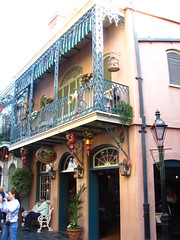 Emerging from the untamed jungles of themed hyperreality in its rawest, most base form, we encounter a time and a place in which man was able to discover something beautiful out of the primordial soup. Just as the real New Orleans created a rich cultural paradise in the Louisiana swamplands, so too did Walt Disney manage to craft an environment slightly more conducive to the emotional riches of storytelling from a swampland of sterilized imitation. While both attractions ostensibly belong in the same “adventure” genre and use many of the same techniques, Pirates of the Caribbean gets right much of what Indiana Jones Adventure got wrong, despite the difference of nearly thirty years of innovation between the two.
Emerging from the untamed jungles of themed hyperreality in its rawest, most base form, we encounter a time and a place in which man was able to discover something beautiful out of the primordial soup. Just as the real New Orleans created a rich cultural paradise in the Louisiana swamplands, so too did Walt Disney manage to craft an environment slightly more conducive to the emotional riches of storytelling from a swampland of sterilized imitation. While both attractions ostensibly belong in the same “adventure” genre and use many of the same techniques, Pirates of the Caribbean gets right much of what Indiana Jones Adventure got wrong, despite the difference of nearly thirty years of innovation between the two.
A book is not afraid to show that it has a cover and is made of bounded paper, nor is a stage play afraid to call intermission or bring the cast to the stage for a round of applause, even if their characters are supposed to be dead. A good story is never ruined by the conscious revelation that it is, in fact, an invented work of fiction. By contrast, Indiana Jones Adventure was deathly afraid anyone would realize it was actually an amusement park ride,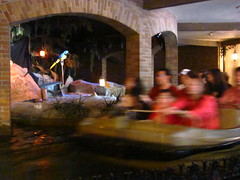 and went to great expense to make sure every loose end was covered up or accounted for so that one might be tricked into believing the adventure was real. But unlike the newer effort, Pirates of the Caribbean is not ashamed of the fact that it peddles in fiction, and in fact it even contextualizes the story in a way that openly acknowledges the dark ride medium it uses.
and went to great expense to make sure every loose end was covered up or accounted for so that one might be tricked into believing the adventure was real. But unlike the newer effort, Pirates of the Caribbean is not ashamed of the fact that it peddles in fiction, and in fact it even contextualizes the story in a way that openly acknowledges the dark ride medium it uses.
The entrance façade has nothing to do with pirates or the Caribbean, instead designed with a lovely pastel and wrought-iron French Quarter architectural style, and once inside the building the queue runs past the return channel in which the boats carousel around a small beach diorama. It resembles a high-class Tunnel of Love more than what I traditionally conceive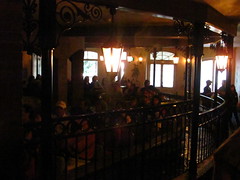 of as theme park ride, feeling as at home at Disneyland as I suspect it could feel if it were a classic at Kennywood or Blackpool Pleasure Beach. This unaffected introduction caught me off-guard, as I was half expecting something that tried to remove the attraction from the world outside and set us in the Caribbean before we even boarded the attraction, much like the version at Disneyland Paris. Even though the lack of building space was as much a necessary blueprint restriction as anything intentionally envisioned by Walt, I actually liked this approach better than the more grandiose Parisian Pirates entrance.
of as theme park ride, feeling as at home at Disneyland as I suspect it could feel if it were a classic at Kennywood or Blackpool Pleasure Beach. This unaffected introduction caught me off-guard, as I was half expecting something that tried to remove the attraction from the world outside and set us in the Caribbean before we even boarded the attraction, much like the version at Disneyland Paris. Even though the lack of building space was as much a necessary blueprint restriction as anything intentionally envisioned by Walt, I actually liked this approach better than the more grandiose Parisian Pirates entrance.
The atmosphere changes as we move deeper into the building, with low light levels magnifying the perceived amount of space inside the station as we wait for our pupils to adjust, the loading area lit only by orange, glowing lanterns. Taking a seat on the six bench boat (an absence of seatbelts make for extremely fast dispatch times) we’re set adrift on a very slow current through an idle Louisiana bayou on a summer night. The amount of measured restraint with this early scene is impressive. Rather than a constant supply of stimuli out of fear we might become bored, the opening scene trusts its audiences will be engaged with the attraction
lit only by orange, glowing lanterns. Taking a seat on the six bench boat (an absence of seatbelts make for extremely fast dispatch times) we’re set adrift on a very slow current through an idle Louisiana bayou on a summer night. The amount of measured restraint with this early scene is impressive. Rather than a constant supply of stimuli out of fear we might become bored, the opening scene trusts its audiences will be engaged with the attraction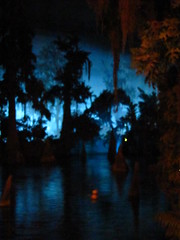 and takes a good two or three minutes to complete, giving ample time to establish the atmosphere, with fireflies dancing in marshes, a dinner party in progress on a nearby plantation house, and the gentle twangs of a banjo plucked by an old resident of a small wooden shack (the vaguely recognizable ‘pirates life’ theme foreshadows the upcoming action in a way that’s not clunky or obvious). The limited color palate of dark black shadows and backlit, swamp haze blues, accented only by the occasional orange firefly or lantern, creates an indelibly impressionistic scene, aided by the equally sparse but effective aural elements. It’s a creative introduction, obviously in part designed to integrate the ride into the New Orleans motif, but it should also call to mind the rich history of American literature that takes place in the waterways of the American south, and frames Pirates as an extension of that literary context.
and takes a good two or three minutes to complete, giving ample time to establish the atmosphere, with fireflies dancing in marshes, a dinner party in progress on a nearby plantation house, and the gentle twangs of a banjo plucked by an old resident of a small wooden shack (the vaguely recognizable ‘pirates life’ theme foreshadows the upcoming action in a way that’s not clunky or obvious). The limited color palate of dark black shadows and backlit, swamp haze blues, accented only by the occasional orange firefly or lantern, creates an indelibly impressionistic scene, aided by the equally sparse but effective aural elements. It’s a creative introduction, obviously in part designed to integrate the ride into the New Orleans motif, but it should also call to mind the rich history of American literature that takes place in the waterways of the American south, and frames Pirates as an extension of that literary context.
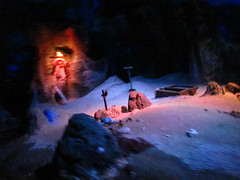 Then as we leave behind the bayou, the peaceful tranquility slowly gives way as the rumble of a waterfall grows nearer. We tip over the edge and are sent hurdling to the bottom with a real splashdown that somehow manages to avoid spraying any water onto the riders. We have now left behind the world of old pirate stories shared around a Louisiana campfire, and have been forcibly flung into the mysterious world of pirate stories itself. We are hit with a second waterfall; these feel much steeper and faster than they really are due to the open, restraintless seating. We navigate an array of flooding caverns, a metaphysical dreamscape seemingly halfway between the realms of the living and the dead, between reality and memories. Populated by skeletons frozen in time, the slow, haunted rendition of the famous theme song and disembodied warning that “dead men tell no tales” betrays the fact that, in this universe, dead men can tell tales. A lightning flash over a sinking ship in the middle of a torrential storm, the skeletal remains of its captain still standing at the helm, is perhaps one of the most lasting images to be found anywhere in the canon of Disney dark rides.
Then as we leave behind the bayou, the peaceful tranquility slowly gives way as the rumble of a waterfall grows nearer. We tip over the edge and are sent hurdling to the bottom with a real splashdown that somehow manages to avoid spraying any water onto the riders. We have now left behind the world of old pirate stories shared around a Louisiana campfire, and have been forcibly flung into the mysterious world of pirate stories itself. We are hit with a second waterfall; these feel much steeper and faster than they really are due to the open, restraintless seating. We navigate an array of flooding caverns, a metaphysical dreamscape seemingly halfway between the realms of the living and the dead, between reality and memories. Populated by skeletons frozen in time, the slow, haunted rendition of the famous theme song and disembodied warning that “dead men tell no tales” betrays the fact that, in this universe, dead men can tell tales. A lightning flash over a sinking ship in the middle of a torrential storm, the skeletal remains of its captain still standing at the helm, is perhaps one of the most lasting images to be found anywhere in the canon of Disney dark rides.
But you know what they say, it’s not the destination that matters, it’s how you get there. That’s true of Pirates of the Caribbean. From this brilliantly imagined netherworld we eventually emerge at our story’s destination, the “real” world of pirates, where we at first find ourselves caught in a cannon battle between two warring galleons. We then enter the town of Puerto Dorado, which has been overrun with robotic pirates doing what pirates do best: pillaging, plundering, swashbuckling, and attempted gang-raping, just like you’d find in any good family theme park. It’s everything we had been waiting and hoping to find when we first set sail, yet now that it was actually in front of me and we had left the atmospheric, slow-simmering first act behind that made Pirates so unique, I felt a little bit deflated. Where will the story take us from here? What compels the narrative now that we’ve discovered the lost world we were searching for? There are bits and snippets of exposition happening in individual scenes, but nothing to tie it all together. It seems our story is resolved by getting to point at the different gags, and comment on how amazing the audio-animatronics are.
To be sure, these scenes are technically the most amazing in the entire ride experience. Some are fairly rudimentary (the “chasing wenches on rotating turntables” gag is quite obvious to everyone) but others are quite impressive (sword fighting pirates rock!). Some effects have been updated, most notably including some newer figures from the film series, and you can see the evolution of the technical design work lined up next to each other. Historically this is the primary reason the ride was developed: to be a showcase for the burgeoning craft of animatronic design, as the originally proposed viewing gallery would not have been sufficient.
What I find most interesting about this sequence is that the development and reliance on audio-animatronics is generally assumed to have been initiated because hiring real actors would have been too expensive. If it weren’t economically unfeasible, populating pirates with living thespians seems like it would result in a better, more realistic pirates ride. That real humans are better than fake humans is only a logical outcome, right?
But then when we actually imagine how the ride would feel if there were live actors in those pirate costumes, paradoxically the attraction seems like it would be worse off. Part of it is because despite the nuanced first act and noble theme park geek delusions, the element of storytelling is not all that important, and the ride is still judged by a technocentric aesthetic criterion where everyone is commenting or thinking about how creative the designers were to be able to manufacture this environment. “How’d they do that?” Fake humans are better than real humans because fake humans are modern marvels of technology that, most importantly, appear expensive. Real humans are ordinary and stupid, and nobody wants to pay just to watch them stand around at their job like we do every other day of the year unless their job involves them taking off some or all of their clothes.
But it’s also because there’s also something discomforting in imagining that these pirates had a brain behind their eyes and could feel feelings. We embark on this journey to the artificial Caribbean to become voyeurs of sorts, to curiously watch a stranger world up close but without becoming a part of it. It’s the same with cinema: we want to have the solipsistic satisfaction that our perspective is the only one that truly matters in this fictional universe, and the people we’re watching can’t watch us back. The pirates are things, representational objects, and they must not have their own subjective content. If they do, then our awareness of things is reflected back on ourselves. We become another physical prop in this setting rather than a non-positional camera obscura, and this world is suddenly haunted by the awareness of the other’s foreign perspective. It is only of robots whose glassy irises you can look deep into and never sense a motivation to avert eye contact.
It’s been nearly a quarter of an hour by the time the pirates decide to torch the place, at which point it’s becoming time for us to escape back into the world from which we came. Now how are we supposed to do that? According to the logic of Walt Disney, because we discovered this world by going down a waterfall, the only way to get back out must be to go up a waterfall. This is exactly what we do. Just as the first waterfalls are narrative devices to signal the boundary lines between reality and fiction, so does this final effect signal a return from the fictional world of pirates to the slightly less fictional world outside of New Orleans. It’s an inspired idea, although unfortunately it doesn’t work as well in practice as it does in theory. The way they manage to create this ‘magic’ is by pulling the boats uphill with a standard chain lift while water pours down and around the incline. It’s not immediately obvious what purpose this lift has besides the immediate mechanical benefit to solve the spatial problem of getting us back to ground level, and it takes several moments to work backwards to figure out what it represents for the overall story arc.
Rather than unnecessary Johnny Depp animatronics, I’d rather a significant upgrade be applied to this last effect. First of all, to ease the intuition over this backwards logic, the water should flow upward rather than downward so we’re not sailing ‘against current’, which I imagine wouldn’t be too difficult to figure out. Secondly, it should hopefully be as exciting a finale as the first two plunges are. Chain lifts are not exciting, and it was at this point that I was starting to get a bit fidgety with the whole ride. To help heighten the illusion that we’re falling up a waterfall, the boats should be quickly whisked to the top at a variable speed that accelerates as we approach the top (but nothing more than 10-15mph, to be sure). I think LSM technology is far enough along that they could easily appropriate the systems used on the uphill waterslides on a larger scale to achieve this effect, with all the appropriate anti-rollback and blocking safety measures. It would give our voyage the rousing, magical finish Walt Disney intended it to have, would help curb the tediousness that starts to grate after a quarter hour sitting on the same ride, and could even give capacity a slight boost (or at least there wouldn’t need to be as many rafts in service at the same time).
Overall the Disneyland version of Pirates of the Caribbean remains one of the best rides in the park, as well as one of the best dark rides you’ll find anywhere in the world. It’s one of the rare few dark rides that are allowed to breathe as they tell their stories, taking ample time to establish setting and mood. Unfortunately, as lovely and accomplished as the narrative framing is to create a compelling story, the picture inside the frame is only a hologram: lightweight, and not really there when you examine it closely. They’re pirates. The name is the story. It’s an attraction in which both creators and spectators value technology above all else,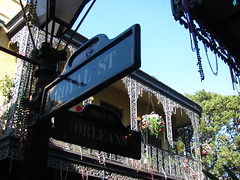 and for everything Walt Disney was able to get right on his last theme park attraction, it’s missing that key ingredient that distinguishes real human storytelling from a series of human-initiated events. What that ingredient is, I’m not certain. But if I want dark rides to compete with other artistic narrative media, I’m going to have to keep looking elsewhere.
and for everything Walt Disney was able to get right on his last theme park attraction, it’s missing that key ingredient that distinguishes real human storytelling from a series of human-initiated events. What that ingredient is, I’m not certain. But if I want dark rides to compete with other artistic narrative media, I’m going to have to keep looking elsewhere.
Our search took us through the heart of New Orleans Square, an extremely impressive avenue that’s lined edge-to-edge with French-Creole architecture, and festooned with glittery bead strings and ornaments celebrating a never-ending Mardi Gras. Part of me wishes New Orleans Square could serve as a model for every other themed environment, as they got the intimacy level perfect. Rather than a large, centralized midway designed from the utilitarian perspective of crowd flow control, there’s a series of smaller pathways that wind and curlicue around buildings and under balconies and promenades, keeping the energy levels from dispersing over a wide open field, especially as we are dazzled by the ornate, colorful details that are typical of Royal Street. It invites a desire for exploration as well as an appreciation of the fine details in a way that other themed environments often fail to do.
from the utilitarian perspective of crowd flow control, there’s a series of smaller pathways that wind and curlicue around buildings and under balconies and promenades, keeping the energy levels from dispersing over a wide open field, especially as we are dazzled by the ornate, colorful details that are typical of Royal Street. It invites a desire for exploration as well as an appreciation of the fine details in a way that other themed environments often fail to do.
Yet at the same time New Orleans Square is also one of the worst Disney theme zones because it’s a simple imitation that imagines nothing new or original. It’s so close a copy of the real French Quarter New Orleans that Louisiana politicians have been able to film their campaign commercials here, and no one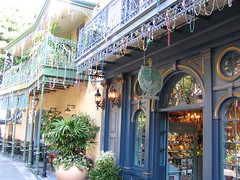 was the wiser until someone noticed the Disneyland trash cans in the background. (Really.) The question becomes, why am I enjoying this city architecture in Disneyland when I can get the real thing without a passport or gated admission ticket? Convenience is the only answer I can think of, as well as not having to deal with some of the less savory element of modern New Orleans. That’s reasonable, but not very romantic. Ideally a themed environment this immersive should spark a desire to return to Disneyland as soon as possible, but instead I found New Orleans Square made me long for Rome, Paris or Barcelona, places which look just as amazing as the Disneyland version, but also have the advantage of being real and letting me explore for more than a minute or two before I reach the outer boundaries into Frontierland._______________
was the wiser until someone noticed the Disneyland trash cans in the background. (Really.) The question becomes, why am I enjoying this city architecture in Disneyland when I can get the real thing without a passport or gated admission ticket? Convenience is the only answer I can think of, as well as not having to deal with some of the less savory element of modern New Orleans. That’s reasonable, but not very romantic. Ideally a themed environment this immersive should spark a desire to return to Disneyland as soon as possible, but instead I found New Orleans Square made me long for Rome, Paris or Barcelona, places which look just as amazing as the Disneyland version, but also have the advantage of being real and letting me explore for more than a minute or two before I reach the outer boundaries into Frontierland._______________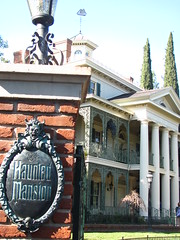
Granted, those cities don’t have an iconic dark ride built in the middle of them, let alone two. At the far end of New Orleans Square we come upon an elegant white plantation house that, without the demarcation sign, one would never guess was actually The Haunted Mansion. It seems so characteristic that Walt Disney could not tolerate anything remotely imperfect or blemished in his park that even an abandoned house of the undead must be presented in pristine condition. Why pirates and ghosts were tolerable inside the buildings when no traces of them were allowed to tarnish anyplace reachable by daylight remains a mystery to me. Yet in retrospect I’m quite glad Disney’s Imagineering team chose the exterior look that they did. Ramshackled haunted houses have become such a theme park cliché, and it’s made more foreboding by the fact that it appears like a normal house on the outside, the sort of place you remember as a child spending the summer weekend with relatives, with all the creaky doors and portraits of dead great-grandparents.
Once we step inside the aesthetic quickly changes, I would argue too dramatically as it doesn’t match up with the building outside. We’re led into an antechamber where we’re given a cordial introduction from our disembodied ghost host. As he speaks there room begins to stretch vertically, the ordinary portraits on the wall revealing a gruesome scene as their bottoms are elongated… and in a particularly dark twist atypical of Disney, the voice suggests there’s always his method as a means of escape from the mansion, whereupon the lights cut out and a flash of lightning reveals for a split second the corporal remains of our host dangling from a noose directly over our heads. It’s a powerful, macabre image that not even the more ‘serious’ Tower of Terror next door is willing to go quite as far to achieve.
I would argue too dramatically as it doesn’t match up with the building outside. We’re led into an antechamber where we’re given a cordial introduction from our disembodied ghost host. As he speaks there room begins to stretch vertically, the ordinary portraits on the wall revealing a gruesome scene as their bottoms are elongated… and in a particularly dark twist atypical of Disney, the voice suggests there’s always his method as a means of escape from the mansion, whereupon the lights cut out and a flash of lightning reveals for a split second the corporal remains of our host dangling from a noose directly over our heads. It’s a powerful, macabre image that not even the more ‘serious’ Tower of Terror next door is willing to go quite as far to achieve.
It is curious, then, that the Haunted Mansion never attempts to out-shock this initial effect once we’re loaded into the ride’s omnimover “Doom Buggy” carriages. Even though the Mansion’s debut in 1969 makes it one of the original ghost trains, to this day it still manages to quietly upend theme park conventions beyond merely the unexpectedly clean façade. The narrative trajectory of most horror stories generally starts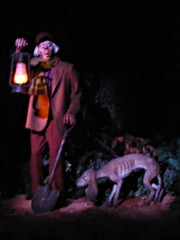 with a lighthearted, normalized ethos, and eventually progresses into a deathly dark pathos. We’ve all seen those movies: a laughing, playful family or group of friends walks into the creaky old house, and later they walk out transformed into a scarred and bloodied (if not very dead) set of individuals. The moral of this story is always the same. Life is fragile and death is Serious; the grave is more for the dead than it is for the living.
with a lighthearted, normalized ethos, and eventually progresses into a deathly dark pathos. We’ve all seen those movies: a laughing, playful family or group of friends walks into the creaky old house, and later they walk out transformed into a scarred and bloodied (if not very dead) set of individuals. The moral of this story is always the same. Life is fragile and death is Serious; the grave is more for the dead than it is for the living.
How radical, then, is the Haunted Mansion, which starts with a dramatic, silent suicide, followed by the undead spirits rapping at the door and a séance, then progresses to a full-scale ballroom dance, and finally concludes with a graveyard bash teeming with dancing and singing undead revelers to an upbeat, jazzy performance of ‘Grim Grinning Ghosts’? In this mansion, it is life that is Serious and a confrontation with death is the only way to finally ‘escape’ and have a bit of fun; the grave is more for the living than it is for the dead. By the time we reach the end the humor has gone straight slapstick. We approach a set of three comical-looking hitchhiking ghosts, the setup to a joke where the punchline is we round the corner and see a reflection of our buggy in which the ghost appears to be sitting right between us. This hallway is otherwise completely barren and fits nowhere in the mansion. It’s just one last special effect joke for its own sake, a final gotcha moment so that everyone who steps off the platform is grinning and laughing as much as the mansion’s residents are.
Still, if there’s one fatal drawback to the Haunted Mansion, it’s that too many visitors are going to be on the edge of their seats not because these themes of life, death, and life-after-death energize the narrative arc so much we can’t wait to find out how it ends, but because they’re trying to figure out if they can spot the riggings that show how they achieved the ballroom hologram effects. As fond as I am of my quasi-Heideggerian death-begets-life interpretation of the Haunted Mansion, it’s unlikely the majority of other riders will even consciously notice the shift in emotional tone between beginning and end. Everywhere we look, technology abounds, begging us to admire it. The special effects are so numerous and varied that it’s impossible to not develop an appreciation for the Imagineer’s work while one is still on the ride. While I’m sure the Imagineers appreciate this recognition (hell, that’s probably why half the effects got included, just to prove to themselves and the world they could build them), it’s very difficult to get lost in the fictive dream of a ghost story if the technical details of the format itself are more attention grabbing than the story itself.
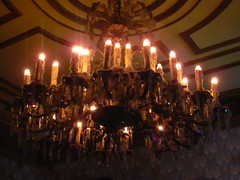 A real ghost story should feel spontaneous, and we watch scary movies half-believing that the events are happening as we witness them (certainly that explains the initial runaway success of the Blair Witch Project). I can’t speak for everyone, but I was always conscious of how precise and scripted every element of the Haunted Mansion had to be. The rising narrative action tends to correlate exactly to the size and complexity of the special effects, and I think it is no coincidence our emotional state seems directly dependent upon how much money and research we believe was spent before us. To find out the house is haunted by real magic would almost be disappointing, as working within the confines of normal physical laws seems far more improbable. By no means is this problem new for Disneyland, nor (I’m sure many would argue)
A real ghost story should feel spontaneous, and we watch scary movies half-believing that the events are happening as we witness them (certainly that explains the initial runaway success of the Blair Witch Project). I can’t speak for everyone, but I was always conscious of how precise and scripted every element of the Haunted Mansion had to be. The rising narrative action tends to correlate exactly to the size and complexity of the special effects, and I think it is no coincidence our emotional state seems directly dependent upon how much money and research we believe was spent before us. To find out the house is haunted by real magic would almost be disappointing, as working within the confines of normal physical laws seems far more improbable. By no means is this problem new for Disneyland, nor (I’m sure many would argue)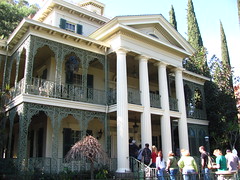 is it even a particularly bad problem to be cursed with… but that doesn’t make it go away.
is it even a particularly bad problem to be cursed with… but that doesn’t make it go away.
Somehow, between the Haunted Mansion and Pirates of the Caribbean, I think there exists a dark ride that’s approaching the ideal I’m searching for. Pirates is able to frame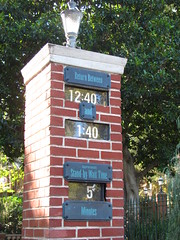 the dark ride experience as an original mode of storytelling such that the symbolic intent is better understood, and Haunted Mansion uses the progression of effects to create an emotional narrative arc that’s not completely devoid of intellectual content if you know how to interpret it. If we could somehow contextualize the Haunted Mansion as a symbolic ghost story and make the special effect techniques feel organic rather than attention-grabbing, then I think Disney would have a true masterpiece that would deserve attention from art critics and the non-geek world at large. As it is right now, we’ve got two fairly decent mechanical magic shows saturated with accomplished set designs and plenty of childhood nostalgia. Since my first time with both these rides was necessarily absent of nostalgia, my personal sojourn for the ideal themed attraction would continue.
the dark ride experience as an original mode of storytelling such that the symbolic intent is better understood, and Haunted Mansion uses the progression of effects to create an emotional narrative arc that’s not completely devoid of intellectual content if you know how to interpret it. If we could somehow contextualize the Haunted Mansion as a symbolic ghost story and make the special effect techniques feel organic rather than attention-grabbing, then I think Disney would have a true masterpiece that would deserve attention from art critics and the non-geek world at large. As it is right now, we’ve got two fairly decent mechanical magic shows saturated with accomplished set designs and plenty of childhood nostalgia. Since my first time with both these rides was necessarily absent of nostalgia, my personal sojourn for the ideal themed attraction would continue.
I’ve been on both of these but in Florida when I was a kid. So it’s interesting that you would bring up nostalgia. Disney is like icing without any cake or ice cream to me. I was young and very happy to go there so it was fun to remember these experiences while reading your review. The Haunted Mansion sounds identical to the one in Orlando. I never noticed the scary to happy story arc like you mentioned. That’s interesting. I’m still impressed by the ball room scene in my memory. Great review!
It took me a few rides on a couple different versions before I noticed the arc too, but if you’re listening to the music you can definitely notice a huge shift in tone from beginning to end. Though I wouldn’t necessarily call it an arc from scary to happy; I think from somber to gallows humor is probably a better descriptor.
If I recall correctly, the Disneyland Paris version has a different storyline, more cohesive and character-driven but also more serious throughout, which I’m not sure if I like as much as the “normal” versions. I’ll have to try it again after having a chance to ride them all.
That story arc is what makes this my favorite Disney attraction.
Unlike you guys, I have a case of extreme nostalgia with this ride. In fact, my first Disney memory is from the graveyard scene.
But as I grew older, I began to appreciate more than just the look and feel of the ride. It always fascinates me to see how many small children will take the chicken exit before even the stretching room. I always felt that the “scary to fun” story arc is even more present in the Florida attraction, as the facade is very much a haunted house.
I’ve taken tons of kids to Disney before, and it’s always interesting to see how hard I have to convince them to ride. The beginning is always especially off putting to kids who have very protective parents. That opening scream terrifies them, and by the end they’re laughing and loving the ride.
I always wondered if this was completely intentional or not…
Oh I definitely think the somber to gallows humor arc was intentional (has anything at Disney ever been attributable to a ‘happy accident’?), although the exact reasons and justifications for it probably vary depending on who you ask. I of course am going to look for a more philosophical interpretation of the Haunted Mansion, but I’m sure there are other explanations that have nothing to do with it.
One comparison I wanted to make to the Haunted Mansion but forgot was the film Dawn of the Dead (the 1978 George Romero version, not the 2004 Zack Snyder remake) has a similar arc. It starts with the destruction of the civilized world and grave intonations that “when there’s no more room in hell the dead will walk the earth”, but then ends with zombies getting pied in the face set to a goofy polka soundtrack. Of course it’s still far from a ‘happy’ ending, but it’s one of those unexpected arcs that that film student wannabes can probably continue to debate interpretations for decades to come.